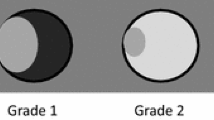Abstract
We retrospectively reviewed computed tomographic (CT) findings of 118 patients with hepatoma who received sequential follow-up CT after transcatheter arterial embolization (TAE). Thirty-five patients received TAE using Gelfoam particles with cisplatin, 37 patients using Gelfoam particles and iodized oil (Lipiodol) with cisplatin, and 46 patients using iodized oil with cisplatin. Liver atrophy was observed in 33 patients, lobarly or focally, depending on the embolized area. It was frequently associated with portal vein occlusion by the tumor, usage of iodized oil, and repeated embolization therapy. The lobar atrophy was seen in patients who had portal vein occlusion and/or received repeated embolization therapy. The focal atrophy was observed in patients who were administered iodized oil. Infarction developed in four patients who had a thrombus in the portal vein and received peripheral embolization therapy using iodized oil. We conclude that liver parenchymal changes occur frequently in patients who have portal vein occlusion and/or receive peripheral embolization using iodized oil.
Similar content being viewed by others
References
Ohishi H, Uchida H, Yoshimura H, et al. Hepatocellular carcinoma detected by iodized oil: use of anticancer agents. Radiology 1985;154:25–29
Nakamura H, Hashimoto T, Oi S, et al. Treatment of hepatocellular carcinoma by segmental hepatic artery injection of adriamycin-in-oil emulsion with overflow to segmental portal vein. Acta Radiol 1990;31:347–349
Yamashita Y, Takahashi M, Koga Y, et al. Prognostic factors in the treatment of hepatocellular carcinoma with transcatheter arterial embolization and arterial infusion. Cancer 1991;67:385–391
Torres WE, Whitmire LF, Gwdgaudas-McClees K, Bernardino ME. Computed tomography of hepatic morphology changes in cirrhosis of the liver. J Comput Assist Tomogr 1986;10:47–50
Novak D. Complications of arterial embolization. In: Dondelinger RF, Rossi P, Kurdziel JC, Wallace S, eds. Interventional radiology. Stuttgart: George Thieme Verlag, 1990: 314–324
Wyngaarden JB, Smith LH, eds. Cecil, text book of medicine, 18 ed. Philadelphia: WB Saunders, 1988:847
Popper HL, Jefferson NC, Necheles H. Interruption of all arterial blood supply to the liver not compatible with life. Am J Surg 1952;84:429–431.
Couanet D, Shirkhoda A, Wallace S. Computed tomography after partial hepatectomy. J Comput Assist Tomogr 1984; 8:453–457
Ham JM. Lobar and segmental atrophy. World J Surg 1990;14:457–462
Rossi P, Sposito M, Simonetti G, Sposato S, Cusumano G. CT diagnosis of Budd-Chiari syndrome. J Comput Assist Tomogr 1981;5:366–369
Khan KN, Nakata K, Kusumoto Y, et al. Evaluation of nontumorous tissue damage by transcatheter arterial embolization for hepatocellular carcinoma. Cancer Res 1991;51:5667–5671
Kartner DH. Hepatic infarction. Arch Intern Med 1965;115:479–481
Author information
Authors and Affiliations
Rights and permissions
About this article
Cite this article
Yamashita, Y., Torashima, M., Oguni, T. et al. Liver parenchymal changes after transcatheter arterial embolization therapy for hepatoma: CT evaluation. Abdom Imaging 18, 352–356 (1993). https://doi.org/10.1007/BF00201780
Received:
Accepted:
Issue Date:
DOI: https://doi.org/10.1007/BF00201780




